人教版英语八年级下册unit1教案新部编本
人教版八年级下英语Unit1SectionA1(1a–2c)教学设计
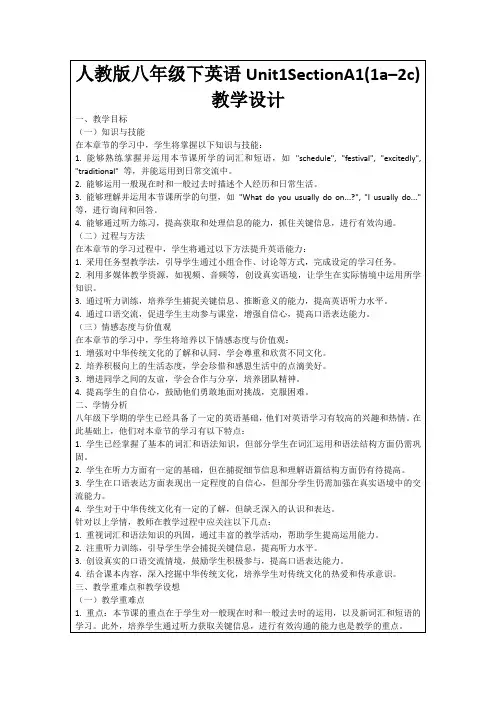
八年级下学期的学生已经具备了一定的英语基础,他们对英语学习有较高的兴趣和热情。在此基础上,他们对本章节的学习有以下特点:
1.学生已经掌握了基本的词汇和语法知识,但部分学生在词汇运用和语法结构方面仍需巩固。
2.学生在听力方面有一定的基础,但在捕捉细节信息和理解语篇结构方面仍有待提高。
3.学生在口语表达方面表现出一定程度的自信心,但部分学生仍需加强在真实语境中的交流能力。
5.鼓励学生在课后继续关注和了解中外文化,提高跨文化交际能力。
五、作业布置
为了巩固本节课的学习内容,培养学生的英语应用能力,特布置以下作业:
1.写作作业:
请学生结合所学知识,以"My Favorite Festival"为题,写一篇不少于80词的英语作文。要求描述自己最喜欢的节日,包括节日的时间、庆祝活动以及感受等,尽量运用本节课所学的词汇和短语。
4.结合课本内容,深入挖掘中华传统文化,培养学生对传统文化的热爱和传承意识。
三、教学重难点和教学设想
(一)教学重难点
1.重点:本节课的重点在于学生对一般现在时和一般过去时的运用,以及新词汇和短语的学习。此外,培养学生通过听力获取关键信息,进行有效沟通的能力也是教学的重点。
难点:学生在实际语境中灵活运用一般现在时和一般过去时,以及正确使用新词汇和短语进行表达。
4.学生对于中华传统文化有一定的了解,但缺乏深入的认识和表达。
针对以上学情,教师在教学过程中应关注以下几点:
1.重视词汇和语法知识的巩固,通过丰富的教学活动,帮助学生提高运用能力。
2.注重听力训练,引导学生学会捕捉关键信息,提高听力水平。
3.创设真实的口语交流情境,鼓励学生积极参与,提高口语表达能力。
新人教版八年级英语下册Unit1 教案
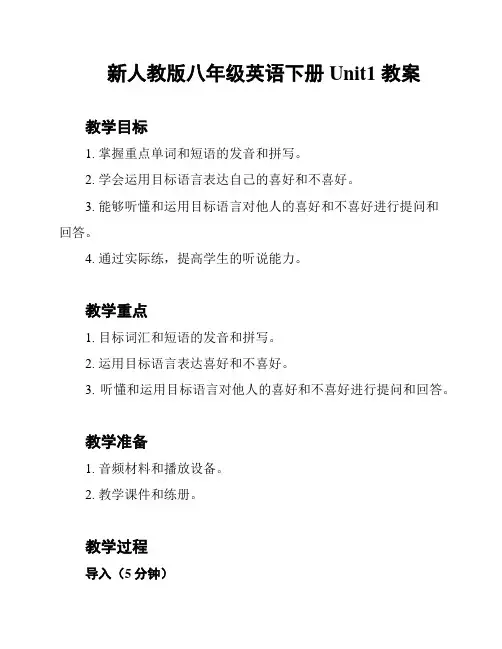
新人教版八年级英语下册Unit1 教案教学目标1. 掌握重点单词和短语的发音和拼写。
2. 学会运用目标语言表达自己的喜好和不喜好。
3. 能够听懂和运用目标语言对他人的喜好和不喜好进行提问和回答。
4. 通过实际练,提高学生的听说能力。
教学重点1. 目标词汇和短语的发音和拼写。
2. 运用目标语言表达喜好和不喜好。
3. 听懂和运用目标语言对他人的喜好和不喜好进行提问和回答。
教学准备1. 音频材料和播放设备。
2. 教学课件和练册。
教学过程导入(5分钟)1. 看图说词。
通过展示一些图片,帮助学生复并研究本单元的目标单词和短语。
2. 回答问题。
提问学生对于不同事物的喜好和不喜好,引出本单元的话题。
主体(30分钟)1. 听力训练。
播放目标语言对话或短文,要求学生听懂并回答相关问题。
2. 语法讲解。
介绍表达喜好和不喜好的目标语言结构,例如"I like..."和"I don't like..."。
3. 口语练。
进行口语练,让学生运用目标语言向他人询问和表达喜好和不喜好。
4. 配对练。
将学生分成小组,让他们根据提供的图片或提示进行对话练,表达彼此的喜好和不喜好。
5. 听力训练。
再次播放目标语言对话或短文,要求学生听懂并填写相关信息。
拓展(15分钟)1. 真实对话。
让学生以小组形式进行真实对话,互相了解彼此的喜好和不喜好。
2. 创作练。
要求学生根据自己的实际情况编写一篇关于自己喜好和不喜好的短文。
3. 分享和展示。
学生可以互相分享自己的短文,并选择几位同学进行展示。
小结(5分钟)1. 总结本节课研究的目标语言和知识点。
2. 引导学生反思研究效果,并给予相关鼓励。
教学反思本节课通过听说训练和实际练习,帮助学生掌握了目标词汇和短语的发音和拼写,并能够运用目标语言表达喜好和不喜好。
课堂中加入了互动的口语练习和小组活动,使学生积极参与,提高了听说能力和学习兴趣。
下一节课可以进一步拓展学生的应用能力,引导他们用目标语言进行更多的实际情境练习。
人教版英语八年级下册unit1全单元教案
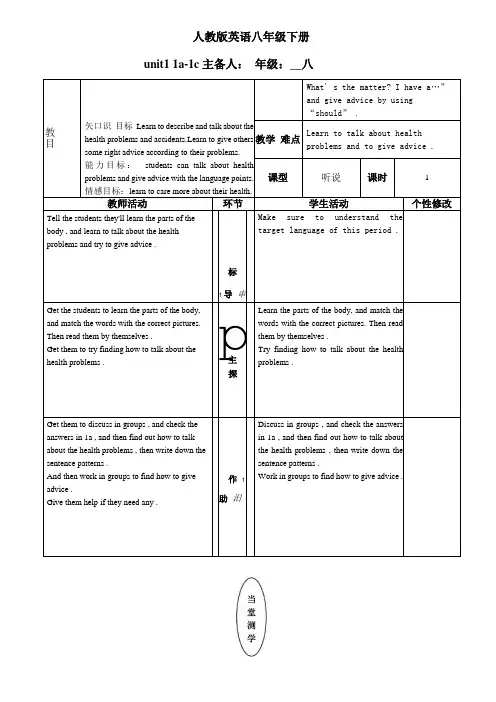
人教版英语八年级下册unit1 1a-1c 主备人:年级:__八学生课堂学习情况反馈教学反思学标教目矢口识目标Learn to describe and talk about the health problems and accidents.Learn to give others some right advice according to their problems.能力目标:students can talk about health problems and give advice with the language points.情感目标:learn to care more about their health.教师活动环节First have a dictation of the new words learned yesterday.Tell them they'll continue to learn how to talk about health problems and give advice .小标导J 审Ask the students to guess what 's the matter with the students in 2a .Then try to find the advice to differentproblems .Get them to translate the phrases . G 主探Play the recording and get them to finish 2a and 2b .Ask them to make conversations according to the listening material .1A作助 1审鬻What' s the matter? I have a…”and give advice by using“should” .教学难点Learn to talk about healthproblems and to give advice .课型听说课时 2学生活动个性修改Have a dictation of the new wordslearned yesterday.Go over the points learned yesterday .Guess what 's the matter with the studentsin 2a and write down .Find the advice to different problems .Translate the phrases .Finish 2a and 2b .Make conversations according to thelistening material .学生课堂学习情况反馈教学反思学科英语课题《unitl 2d , 4b》主备人:年级:__八学标教目知识目标:Learn to give others some right advice according to their problems.能力目标:Enable students to talk about health problems and give advice with the language points.情感目标:Students care more about themselves and their family members ' health.教师活动环节Tell them that they'll continue to learn how totalk about health problems and give advice.Today they'll learn a conversation and talkabout health problems.标1导刘Ask the students to read the dialogue bythemselves , underline the new words and thewords they don't know.Get them to answer the questions given by the teachers. G 主探Get them to work together and find out theanswers according to the conversation. Then role play the conversations. A作助旧教学重点Learn to talk about healthproblems by using “What' s thematter? I have a …” and giveadvice by using “should”.教学难点Learn to give appropriate adviceto the certain health problems.课型听说课时 3学生活动个性修改Continue to learn how to talk abouthealth problems and give advice.Learn a conversation and talk about health problems.Read the dialogue by themselves ,underline the new words and the wordsthey don't know.Answer the questions given by theteachers.work together and find out the answersaccording to the conversation.Then role play the conversations.学生课堂学习情况反馈教学反思学科英语课题《unit 1 grammar-4b》主备人:年级:_八学科英语课题《unitl section B 1a- 1c》主备人:年级:_八教学资源(含自编习题、阅读文章、听力资料、知识链接等)学科英语课题《unitl section B 2b-2e》主备人:_年级:_八学科英语课题《unitl self check》主备人:_年级:_八__。
人教版八年级英语下册Unit1SectionA(2d3c)教学设计
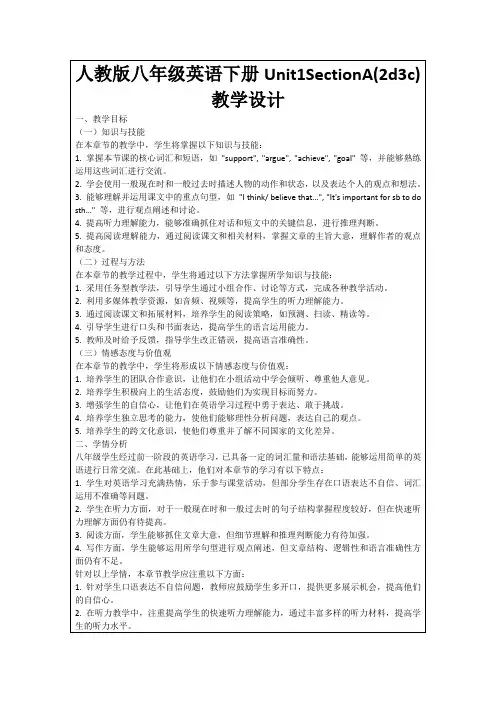
(一)教学重难点
1.重点:本节课的重点在于使学生掌握一般现在时和一般过去时的用法,以及运用目标词汇和句型进行观点表达。
难点:听力部分中,学生对快速听力材料中的细节信息捕捉能力不足;写作部分,学生在文章结构、逻辑性和语言准确性方面存在困难。
2.教学难点突破策略:
(1)针对听力难点,通过设计不同难度的听力任务,逐步提高学生的听力水平。同时,教授学生听力策略,如预测、关键词定位等,提高他们对细节信息的捕捉能力。
2.讨论话题:My dream/ goal and how I plan to achieve it.(我的梦想/目标以及我打算如何实现它。)
3.教师指导:教师巡回指导,关注每个小组的讨论情况,适时给予提示和帮助。
4.小组展示:各小组向全班展示讨论成果,其他同学认真倾听,学习借鉴。
(四)课堂练习
1.教学活动设计:设计不同类型的练习题,帮助学生巩固所学知识。
3.学生回答:鼓励学生用英语表达自己的观点,激活已有知识,为新课学习做好铺垫。
4.教师总结:教师总结学生的回答,引出本节课的主题——谈论目标与梦想。
(二)讲授新知
1.教学活动设计:教师结合课文内容,讲解一般现在时和一般过去时的用法,以及目标词汇和句型。
2.语法讲解:通过示例句、图表等方式,帮助学生理解并掌握两种时态的用法。
3.能够理解并运用课文中的重点句型,如"I think/ believe that…", "It's important for sb to do sth…"等,进行观点阐述和讨论。
4.提高听力理解能力,能够准确抓住对话和短文中的关键信息,进行推理判断。
5.提高阅读理解能力,通过阅读课文和相关材料,掌握文章的主旨大意,理解作者的观点和态度。
部编版八年级英语下册教案 第一单元教学设计
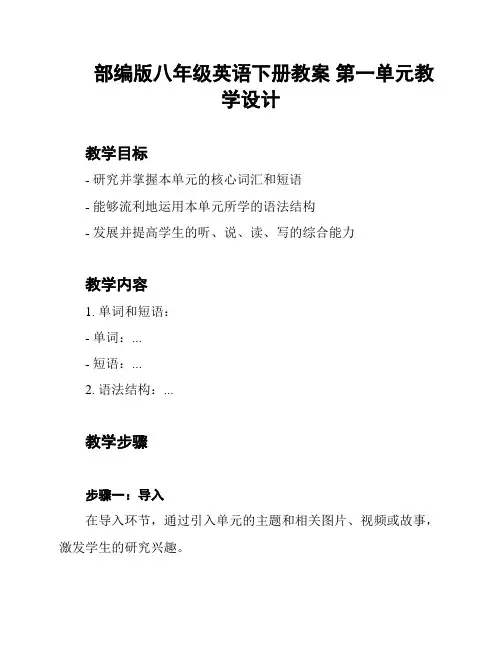
部编版八年级英语下册教案第一单元教
学设计
教学目标
- 研究并掌握本单元的核心词汇和短语
- 能够流利地运用本单元所学的语法结构
- 发展并提高学生的听、说、读、写的综合能力
教学内容
1. 单词和短语:
- 单词:...
- 短语:...
2. 语法结构:...
教学步骤
步骤一:导入
在导入环节,通过引入单元的主题和相关图片、视频或故事,激发学生的研究兴趣。
步骤二:词汇与短语研究
通过多种方式(如图片、单词卡片、游戏等)帮助学生掌握本单元的核心词汇和短语。
步骤三:听力训练
通过听录音、对话或短文,让学生进行听力练,提高他们的听力理解能力。
步骤四:口语练
结合课文内容,安排学生进行口语对话练,帮助他们提高口语表达能力。
步骤五:阅读与理解
学生阅读关于本单元话题的文章,并进行相关的理解练,培养他们的阅读理解能力。
步骤六:语法讲解与练
介绍本单元的语法结构,并通过练巩固学生对该结构的掌握。
步骤七:写作练
引导学生进行写作练,可以是对话、日记、文章等形式,培养他们的写作能力。
步骤八:巩固与复
通过小组活动、游戏或练册等形式,对本单元内容进行巩固和复。
教学评估
通过课堂上的口语表达、书面作业、小组活动等方式,对学生的研究情况进行评估。
教学资源
- 教材:《部编版八年级英语下册》
- 相关图片、视频或故事
- 单词卡片
- 练册
以上是《部编版八年级英语下册教案第一单元教学设计》的大致内容安排,具体的教学细节和活动可根据实际情况进行调整和补充。
希望本教案能帮助到您的教学工作!。
人教版八年级英语下册Unit1单元教学设计
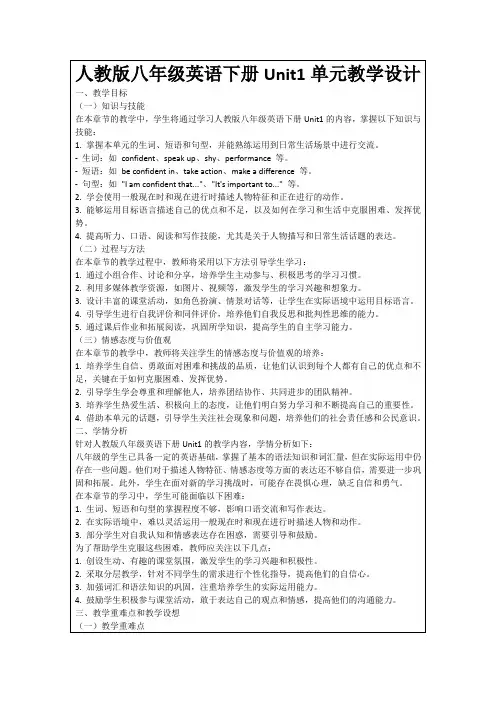
(二)过程与方法
在本章节的教学过程中,教师将采用以下方法引导学生学习:
1.通过小组合作、讨论和分享,培养学生主动参与、积极思考的学习习惯。
2.利用多媒体教学资源,如图片、视频等,激发学生的学习兴趣和想象力。
3.设计丰富的课堂活动,如角色扮演、情景对话等,让学生在实际语境中运用目标语言。
八年级的学生已具备一定的英语基础,掌握了基本的语法知识和词汇量,但在实际运用中仍存在一些问题。他们对于描述人物特征、情感态度等方面的表达还不够自信,需要进一步巩固和拓展。此外,学生在面对新的学习挑战时,可能存在畏惧心理,缺乏自信和勇气。
在本章节的学习中,学生可能面临以下困难:
1.生词、短语和句型的掌握程度不够,影响口语交流和写作表达。
-每组围绕话题展开讨论,运用本节课所学的生词、短语和句型进行人物描述。
2.教学目的:
-培养学生的团队合作精神和沟通能力。
-让学生在实际运用中巩固和拓展所学知识。(四 Nhomakorabea课堂练习
1.教学活动设计:
-设计填空、选择、改错等练习题,让学生完成并进行互评。
-安排口语练习,如角色扮演、情景对话等,检测学生对目标语言的掌握程度。
2.在实际语境中,难以灵活运用一般现在时和现在进行时描述人物和动作。
3.部分学生对自我认知和情感表达存在困惑,需要引导和鼓励。
为了帮助学生克服这些困难,教师应关注以下几点:
1.创设生动、有趣的课堂氛围,激发学生的学习兴趣和积极性。
2.采取分层教学,针对不同学生的需求进行个性化指导,提高他们的自信心。
2.教学过程:
-通过PPT展示生词、短语和句型,让学生跟读并模仿。
人教版八年级英语下册Unit1What’sthematter(16课时)教学设计
2.增强学生的健康意识,使其认识到健康的重要性,养成良好的生活习惯。
3.培养学生积极向上的心态,面对困难和挫折时,能够保持乐观,寻求帮助。
4.通过学习英语,拓宽学生的国际视野,使其了解并尊重不同文化背景下的健康观念。
5.鼓励学生参与课堂活动,增强自信心,培养合作精神。
3.加强词汇教学,通过游戏、竞赛等形式,帮助学生记忆和巩固词汇。
4.设计多样化的听力练习,提高学生的听力水平,培养其英语语感。
5.关注学生的情感态度,引导他们正确面对健康问题,培养积极的心态。
三、教学重难点和教学设想
(一)教学重难点
1.词汇和短语:本章节的重点词汇和短语涉及描述健康问题的各个方面,如身体部位、症状等。这些词汇和短语的掌握对于学生能够流畅地表达和交流至关重要。
3.听力训练:利用课外时间,观看英语原声视频,如健康主题的TED演讲或医生与患者的对话,提高听力水平,并记录下新学到的表达方式。
4.口语作业:与同学组成小组,进行角色扮演,录制一段关于健康问题的对话视频,要求每个成员都有发言机会,并在视频中加入适当的身体语言。
5.写作练习:写一篇关于“如何保持健康生活方式”的短文,至少80词,使用本节课学习的词汇和句型,表达个人观点。
3.学生分享:鼓励学生分享自己在生活中遇到的健康问题及解决方法,激发学生兴趣,为新课学习做好铺垫。
(二)讲授新知
1.教学内容:教师针对本节课的重点词汇、短语和句型进行讲解,如:“What’s the matter?” “I have a toothache/too much homework.” “You should/need to…”等。
人教版八年级英语下册-Unit1-教案
人教版八年级英语下册-Unit1-教案教学目标- 学生能够掌握并正确运用本单元的词汇和短语。
- 学生能够熟练运用本单元所学的句型进行口语表达。
- 学生能够通过阅读和听力理解本单元的相关话题。
- 学生能够参与到小组讨论和角色扮演的活动中,进一步提高口语交流能力。
教学内容一、词汇本单元重点词汇和短语包括:environmental, influence, pollution, reduce, recycle, waste, energy, natural resources, electric, appliance等。
二、语法本单元主要研究以下句型:1. It's important to + 动词。
例如:It's important to protect the environment.2. What should/could we do to + 动词?例如:What should we do to reduce pollution?三、听说读写通过听力活动和阅读材料,让学生了解有关环境保护的知识,并提高他们的听说读写能力。
四、口语交流组织小组讨论和角色扮演的活动,让学生通过对话的方式进行口语练,提高他们的口语交流能力。
五、拓展活动邀请环保专家或相关领域的人士来学校进行讲座,让学生进一步了解环保知识,并激发他们保护环境的意识和行动。
教学步骤第一课时1. 导入新课,介绍本单元的话题。
2. 学生听音,跟读词汇和短语。
3. 听力练,让学生根据听到的对话内容选择正确的图片。
4. 提出问题,让学生讨论并说出不同的解决办法。
第二课时1. 复上节课的内容,让学生回顾所学的词汇和句型。
2. 阅读活动,让学生阅读课文,并回答相关问题。
3. 角色扮演,让学生根据课文中的对话内容进行角色扮演。
第三课时1. 复上节课的内容,进行口头测试,检查学生对所学内容的掌握情况。
2. 小组讨论,让学生分组讨论如何保护环境,并给出建议。
人教版八年级英语下Unit1What’sthematter(SectionA3a4c)教学设计
3.学生能够在听力活动中,捕捉关键信息,提高听力理解能力。
4.学生能够通过小组合作,运用所学知识进行情景交际,提高口语表达能力。
(二)过程与方法
1.通过听力练习,让学生学会在真实的语境中捕捉关键信息,培养其英语听力策略。
2.通过小组合作,让学生在讨论和交流中学会用一般现在时态描述身体不适的情况,提高其语言运用能力。
-角色扮演:学生分组进行角色扮演,模拟医生与病人的对话场景,练习一般现在时态描述身体状况。
-小组讨论:学生以小组为单位,讨论家庭成员的健康状况,用英语进行汇报,提高口语表达能力。
2.针对教学难点,采用以下策略:
-针对听力难点,教师在课堂上可以逐步提高语速,增加语境的复杂性,引导学生逐步适应。
-在小组合作中,教师注意观察学生的参与情况,鼓励主动性差的学生积极参与,培养他们的团队协作能力。
3.教师在批改作业时,要关注学生的进步和问题,及时给予反馈和指导。
4.学生在完成作业过程中,如有疑问,可随时向教师请教,提高学习效果。
2.教师展示一张身体部位的图片,引导学生用英文说出图片中的身体部位名称,回顾已学的身体部位词汇,为新课的学习做好铺垫。
3.教师播放一段与课程内容相关的录音,让学生尝试听懂录音中的句子,为新课的学习营造语境。
(二)讲授新知
1.教师呈现新课的词汇,如:“toothache”、“stomachache”等,通过图片、动作等方式让学生理解并记忆这些词汇。
三、教学重难点和教学设想
(一)教学重难点
1.重点:学生能够熟练运用本节课所学的身体部位及不适的词汇,如:“toothache”、“stomachache”等,以及一般现在时态描述和询问他人的健康状况。
人教版八年级英语下册Unit1单元教学设计
1.教师呈现本单元的词汇表,引导学生学习并掌握新词汇。通过图片、例句、同义词等方法,帮助学生理解和记忆单词。
2.讲解一般现在时的用法,结合课文中的句子,让学生了解并掌握一般现在时用于描述人物特点、日常生活等方面的用法。
3.教师展示课文,带领学生阅读并分析课文结构。讲解课文中的重点句子、短语和语法点,帮助学生理解文章内容。
5.情感态度与价值观方面,结合课文内容,设计相关话题的讨论和分享,让学生在交流中培养跨文化意识,学会尊重和欣赏他人。
6.教学评价方面,采用形成性评价和终结性评价相结合的方式。关注学生在课堂活动中的表现,鼓励他们积极参与,及时给予反馈。同时,在单元结束时进行总结性评价,检验学生的学习成果。
四、教学内容与过程
难点:培养学生快速阅读、准确把握文章主旨和细节的能力,以及运用阅读策略提高阅读效率。
3.重点:培养学生的写作能力,能够仿照课文写出关于人物描述的短文。
难点:如何指导学生在写作过程中注意文章结构、句子连贯性和用词准确性。
(二)教学设想
1.针对词汇和短语的学习,采用图片展示、情景剧表演等多种教学方法,帮助学生形象、直观地理解和记忆。同时,设计丰富的课堂活动,如单词接龙、小组竞赛等,激发学生的学习兴趣。
5.培养学生的跨文化意识,使他们了解并尊重不同国家、民族的风俗习惯,增进与世界各国人民的友谊。
二、学情分析
八年级学生经过前两年的英语学习,已具备一定的英语基础,对英语学习有较高的兴趣。在本单元学习前,学生已经掌握了基本的词汇、语法和句型,能够运用一般现在时描述日常生活和兴趣爱好。但在实际运用中,部分学生对词汇、短语的记忆和运用仍存在困难,需要教师在教学过程中给予关注和指导。
3.教师根据学生的回答,自然过渡到本单元的主题:“Today we are going to learn how to describe a person's personality, appearance and hobbies in detail using the present simple tense.”
- 1、下载文档前请自行甄别文档内容的完整性,平台不提供额外的编辑、内容补充、找答案等附加服务。
- 2、"仅部分预览"的文档,不可在线预览部分如存在完整性等问题,可反馈申请退款(可完整预览的文档不适用该条件!)。
- 3、如文档侵犯您的权益,请联系客服反馈,我们会尽快为您处理(人工客服工作时间:9:00-18:30)。
教师学科教案[ 20 – 20 学年度第__学期]任教学科:_____________任教年级:_____________任教老师:_____________xx市实验学校Unit1 What’s the matter?1. KnowledgeWords: have, cold, back, arm, ear, eye, foot, hand, head, leg, mouth, neck, nose, tooth, fever, rest, should, headache, ago, so, illness, thirsty, early, problem, way, traditional, believe, weak, angry, medicine, western, everybody, get, few, stay, important, moment, late, until, yesterday, hear Phrases: have a cold, be stressed out, a few, at the momentStructures: Have for talking about health problems.Modal: should / shouldn’t2. SkillsTalk about your health.Give advice.3. Learning StrategiesUsing what you know.Inferring content.II. BackgroundIII. Teaching Time: Six PeriodsPeriod OneTeaching Aims:1. Learn and master the following words and phrases: matter, have, cold, have a cold, stomachache, sore, back, arm, ear, foot, hand, head, leg, mouth, neck, nose, stomach, tooth, throat2. Develop the students’ listening ability.3. Be able to talk about health.4. Sentence PatternsWhat’s the matter? I have a sore throat.Teaching Difficult PointThe sentence patterns.Teaching MethodsListening practice to train the students’ listening ability.PairwrokTeaching AidsSome pictures.A tape recorder.Teaching ProceduresStep I Greetings.Step II. 1aTeach the students to study the new words by showing some pictures.eye, nose, mouth, ear, tooth, face, head, neck, back, stomach, arm, hand, leg, footAsk a student to read the list of thirteen names of body parts.Then let the students look at the picture and write the correct letter for each part of the body. Check the answers.Answers:k arm c back g ear i eye m foot a hand l head b leg f mouth e tooth d neck j nose h stomachStep III 1bShow some illnesses.e.g. I have a cold. I have a stomachache. Let several students say some illnesses.Ask a student to read the names. Nancy, Sarah, David, Ben, JudyThen play the recording the first time. Students only listen. Play the recording a second time. Students number the names.Cheek the answersAnswers:Nancy = 3 Sarah = 1 David = 2 Ben = 5 Judy = 4Step IV 1cAsk two students to read the conversation.A: What’s the matter?B: I have a sore throat.Then let the students make conversations in pairs.After some minutes, ask several pairs to say their conversations.Explain the language points.1. What’s the matter? 你怎么啦?这句话在口语中很常见,当别人遇到什么麻烦,或身体不舒服,你就可以问What’s the matter?意思是你怎么啦?/ 你遇到什么麻烦啦?/ 你哪儿不舒服?还可以在句末用介词with表示对象。
e.g. —What the matter with you? 你怎么啦?—I can’t find my ticket. 我打不到我的票。
—What’s the matter with your car? 你的车怎么啦?—I can’t start it. 它发动不了了。
2. “have + a +疾病名”表示“患……(病)。
”have a cold (患)感冒have a stomachache 胃痛have a sore back 背痛have a toothache (患) 牙痛have a sore throat (患)咽喉痛have a fever 发烧,发热have a headache (患)头痛have a backache 背痛Step V Summary and HomeworkSummarize what the students have learnt and give them some homework.To make conversations in 1c in pairs.To do some exercises.Period TwoTeaching Aims1. Learn and master the following words: toothache, fever, rest, honey, dentist, should, headache, shouldn’t= shouldnot2. Develop the students’ listening ability.3. Be able to give advice.4. Sentence PatternsWhat’s the matter? I have a toothache.Maybe you should see a dentist. That’s a good idea.He has a stomachache. He shouldn’t eat anything.She has a toothache. She should see a dentist.Teaching Difficult PointThe sentence patterns.Teaching methodsListening practice to train the students’ listening ability.PairworkTeaching AidsA tape recorder.A projector.Teaching Procedures.Step I. Greetings.Step II. RevisionAsk several pairs of students to say their conversations.Do some exercises.写出人体各部分的英语名称。
Step III. 2aTeach the students to study the new words by a projector.toothache n. 牙痛fever n. 发烧;发热rest n. 休息honey n. 蜂蜜dentist n. 牙医should v. 应该headache n. 头痛shouldn’t = should notAsk a student to read the eight items to the class:fever, sore throat, stomachache, toothache, lie down and rest, hot tea with honey, see a dentist, drink lots of waterThen play the recording the first time. Students only listen.Play the recording a second time. Students match the problems with the advice.Check the answers.Step IV 2bAsk the students to look at the pictures. Ask, what can you see in the pictures?Then play the recording again. Ask the students to fill in the blanksCheck the answersStep V 2cAsk two students to read the conversation.A: What’s the matter?B: I have a toothache.A: Maybe you should see a dentist.B: That’s a good idea.Then let the students make conversations in pairs.After some minutes, ask several pairs to say their conver sations.Explain the language point.Maybe you should see a dentist.Step VI Grammar FocusAsk the students to read the sentences.I have a headache. You should go to bed.He has a stomachache. He shouldn’t eat anything.She has a toothache. She should see a dentist.Then let the students make similar sentences.Step VII. Summary and HomeworkSummarize what the students have learnt and give them some homework.To remember the grammar focus.Period ThreeTeaching Aims:1. Learn and master the following words: ago, so, illness, advice2. Sentence PatternsWhat’s the matter? I’m not feeling well. I have a cold.When did it start? About two days ago.Oh, that’s too bad. You should get some rest.Yes, I think so. I hope you feel better soon.3. Review how to talk about health and give advice.Teaching Difficult PointThe sentence patterns.Teaching MethodsPairwork.Groupwork.Teaching AidA projector.Teaching ProceduresStep I. Greetings.Step II. RevisionStep IV 3bAsk the students to read the conversations in 3a in pairs.After some minutes, ask several pairs to say the conversations.Then let the students look at the picture. Ask, what’s the mater with the people in the picture? (He has a toothache. She has a sore back. He has a sore throat. She has a stomachache.) After some minutes, ask several pairs to say their conversations.Step V 4Read the conversation to the class.A: What’s the matter? Do you have a sore throat?B: No, I don’t.C: Do you have a headache?B: Yes, I do.D: You should lie down and rest.Read the instructions and demonstrate what a “mime” is.e.g. Hold your tooth as if you have a toothache. Say, I’m miming a toothache.Ask a student to the classroom of the from and mime an illness. Let the rest of the class guess what the illness is.Give several students an opportunity to come to the front and mime an illness.Step VI Summary and HomeworkSummarize what the students have learnt and give them some homework.To make conversations in 3a in pairs.Period FourTeaching Aims:1. Learn and master the following words:thirsty, early, problem2. Sentence PatternsWhat’s the matter with Gina? She’s tired. She should go to bed early.She shouldn’t go to the party.3. Review how to talk about health and give advice.Teaching Difficult Point.The Sentence Patterns.Teaching Methods.Listening practice to train the students’ listening abilityPairworkTeaching ProceduresStep I Greetings.Step II Revision.Step III 1aAsk the students the four new words and look at the picture.Ask. What are they doing?Let some students answer the questions, then read it.Then let students fill in the blanks.Check the answers.Step IV 1bLet students read the four sentences then read each one again and ask students to repeat the sentences. Listen to the tape.Then let students match each pictureWith one piece of advice. Write the letter of the picture in front of the sentence that gives advice. Correct the answers.Step V 2aLet students look at the chart. Then ask the students listen to the four conversations. Write the problems in the blanks after each person’s name.Correct the answers.AnswersGina: tired Julie: thirstyTony: stressed out Alan: hungryStep VI 2bLet students listen to the four conversations again. Then write what each person should and shouldn’t do for their problems.Answers.Step VII 2cFirst let two students to read the conversation.A: What’s the matter with Gina?B: She’s tired.A: Well, she should go to bed.She shouldn’t go to the party.Let students use the information in Activity 2a to make conversations. Then ask some pairs to perform their conversaions for the class.Step VIII Summary and Homework.Summarize what the students have learnt and give them some homework.To make conversations in 2c in pairs.Period FiveTeaching Aims:Learn and master the following words and phrases way, traditional, believe, weak, angry, medicine, western, everybody, get, few, stay, importantSentence patterns①Traditional Chinese doctors believe we need a balance of yin and yang to be healthy.②Eating Dangshen and Huangqi herbs is also good for this .③It’s easy to have a healthy lifestyle.④People who are too stressed out and angry may have too much yang.Teaching Difficult Point.The sentence patterns.Teaching Methods.Reading practice to train the students’reading ability. Writing practice to train the students’writing ability.Teaching AidA projector.Teaching procedures.Step I GreetingStep II New wordsTeach the students to study the new words by a projectorway n. 方法,方式traditional adj. 传统的,惯例的believe v. 相信,认为weak adj. 虚弱的angry adj. 愤怒的,生气的medicine n. 药western adj. 西方的everybody 每人pron get v. 变得few adj. 很少的,几乎没有的stay v. 保持important adj. 重要的Step III 3aRead the article. Then Explain the language points.1. Traditional Chinese doctors believe we need a balance of … Chinese doctors believe that they should eat …在这两个句子中,believe后跟的都是宾语从句,都由that引导,that可以省略。
